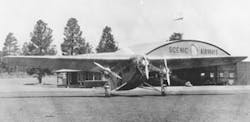Of Terminals and Hangars
In 1929, the Board of Directors of the newly formed Transcontinental Air Transport (TAT) sent a memo to their operations manager, Colonel Charles Lindbergh requesting standard guidelines for transferring passengers to terminals and for strict regulation in aircraft maintenance. Heretofore, no passenger airline had built its own terminals, and landing fields were not yet equipped with transmitting radios or landing lights.
Stops along TAT’s “Coast to Coast in 48 Hours” route (air and rail) offered pilots and ground crew safe and efficient aircraft as well as the comfort of overnight accommodations, hot meals and plenty of restrooms, which were designed after train stations and the southwest’s Fred Harvey restaurants.
Essential on his list of buildings and equipment at each stop were ground vehicle garages for gas trucks (“with two hoses”); a hangar with a mechanic’s shop for aircraft, ticket offices, and passenger and crew lavatories; plus a radio shack and power plant sheds. In outlying areas, employees lived at the airport. Lindbergh listed “optional” equipment for ground support: flares or oil drums (for landings after dark); hand water pumps, globes or beacons; and a public announcement system. (At some terminals the arrival and departure “announcements” were shouted through a megaphone by a uniformed employee.) Between 1929 and 1930, TAT flew thousands of passengers in Ford Tri-Motors and other aircraft from New York to Los Angeles.
The concept of municipal airports caught on in the 1920s and engineering architects like Benson Russell Shaw were instrumental in the design of hangars and terminals.
Benson Russell Shaw [1893-1961] - Airport Architect
Born in Ohio, Shaw had a long, distinguished career as a pioneer aviator (licensed in 1910), aircraft designer, inventor, and air race organizer. He held several management positions for the Wright brothers, Lawson Airplane Company and others; and formed the Aero Instrument Corporation.In Michigan, between 1925 and1927, he was in charge of Henry Ford’s airports and was chief airport engineer for Stout Airlines.
In 1928, when TAT connected to Scenic Airways Inc. with operations in Phoenix, and at the Grand Canyon, Arizona, Shaw was hired to build their hangars and terminals. Over rough dirt roads, Shaw trucked in steel pre-formed I-beams, off-loaded in Williams from cross-country trains. Fifteen-foot tall wood and steel sliding hangar doors manufactured by Richards-Wilcox were set in place. Scenic’s terminal building was divided into a passenger lounge, office, machine shop, parts shop, vehicle repair bay, and room for a Ford Tri-Motor and one more smaller aircraft. When it was done, Shaw embossed his name into the cement base of the hangar doors. Scenic’s founder, Parker Van Zandt made sure that passengers were chauffeured, fed, and treated to views from the air that tourists to the Grand Canyon state had never seen before. Luggage was carefully weighed, stowed and rarely damaged or lost. Lindbergh flew in for a visit to the original Grand Canyon Airport, as did other famous fliers such as Amelia Earhart.
As air travel expanded west, Shaw was hired by the city of Flagstaff, Arizona, to design their first “airport” in 1928. A hangar and runways were constructed in a flat meadow with a view to the San Francisco Peaks. The local paper reported, “Three prisoners from the city jail were taken to the field and the land is being cleared of fences.” The proud citizens named it Koch Field, after their air-minded Mayor.
That same year, the City of St. Louis hired Shaw to improve their existing facilities at Lambert field where Lindbergh had flown air mail to Chicago. Lambert St.-Louis Municipal Airport was the first owned by a municipality in the U.S.
A decade later, four-engine, passenger aircraft required more sophisticated hangars and terminals separate from maintenance operations. Between 1931 and 1937 Pan American Airways (PAA) flew enormous flying boats designed by Sikorsky and Boeing, and hired Lindbergh as an operations consultant. PAA destinations included China, Hawaii and other exotic ports, where special water ferries linked passengers to their luxurious aircraft.
PAA’s airframes were subject to corrosion, and Lindbergh later observed that “operating in a semi-tropical area with the added problem of salt water take-offs and landings …was a maintenance nightmare.” Sikorsky’s S-40 aircraft which were specifically designed for PAA’s North and South American routes had a 114-foot one-piece wing under which hung four engines. It was supported by so many struts that Lindbergh called it the “Flying Forest.”
In 1939, the Sikorsky S-40s and S-42s were replaced by the Boeing 314 Clippers, still considered the most romantic passenger planes ever built. The four-engine Clippers offered mechanics access in the 152-foot wings for minor in-flight repairs. Routine maintenance was done while the Clippers were anchored off-shore or tethered to sea docks. Engine maintenance was done in over-sized hangars (or on the field in mild climates) jammed with a honeycomb of complex scaffolding designed to perfectly accommodate the giant flying boats.
Modern aircraft hangars and passenger terminals still retain the basic elements specified by Lindbergh and constructed by Shaw during the time when travelers wore their best clothes for the occasion — and never worried about lost luggage.
Related Reading: Look for Giacinta’s article on PAA mechanic and maintenance dock designer, Henry “Hank” Anholzer in her column “Past Contact! Mechanics in Aviation History” for Aircraft Maintenance Technology in the July and September 2009 issues. (www.amtonline.com)
Giacinta Bradley Koontz is an aviation historian, former museum director and archaeologist. She is the 2008 recipient of the DAR History Medal and nationally recognized expert on the life of Harriet Quimby, America’s first licensed female pilot